|
Home
Syllabus
Schedule
Assignments
Online
Lectures
Announcements
Discussion
Forum
Review
Textbook
Website
Economics
Glossary
|
The AS / AD Model and the Tax Cut Proposal
Spring 2001
President Bush has proposed a $ 1.6 trillion tax cut over
10 years. One of his arguments favoring the tax cut is that
the economy is "slowing" which means there may be an
increase in unemployment and possibly a recession. We can
use the AS / AD model that we have learned to better
understand the issues surrounding this proposal. This will
be similar to the extra credit essay question on the second
exam.
Please read this following news article from cnnfn.com
[http://cnnfn.cnn.com/2001/02/27/economy/economy/]
. I have highlighted the parts that most concern us. Then we
will analyze the article using our AS/AD model.
|
Confidence
tumbles again
Home
sales fall sharply; U.S. orders come in weaker
than forecast
February
27, 2001: 3:18 p.m. ET
[http://cnnfn.cnn.com/2001/02/27/economy/economy/]
NEW
YORK (CNNfn) - Consumer
confidence
plunged
to a 4-1/2-year low in February, a private
research group said Tuesday, while the U.S.
government released separate reports showing
weakness in housing and durable goods orders
last month.
The data pointed to more weakness ahead for the
U.S. economy and sparked a new round of worries
about the extent of the
economic
slowdown.
Some analysts say the latest round of
disappointing economic reports
could
persuade the Federal Reserve to slash interest
rates
again before the central bank's next meeting
March 20. But others worry that the Fed may not
be able to do enough to ward off a
recession.
. . . .
"The erosion in consumer confidence continues to
be fueled by weakening
expectations regarding business and employment
conditions,"
said Lynn Franco, director of the Conference
Board's Consumer Research Center. "While the
short-term outlook continues to signal a severe
economic downturn, consumers' appraisal of
current economic conditions suggests
we
are still undergoing moderate growth and not a
recession."
. . . . .
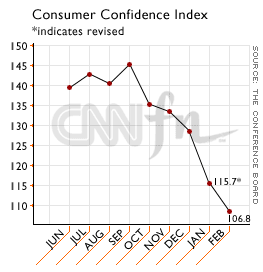 Adding
to the pessimism Tuesday were two reports
released by the Commerce Department. Adding
to the pessimism Tuesday were two reports
released by the Commerce Department.
The government said new home sales registered
their sharpest monthly decline in seven years
last month, suggesting that the overall economic
slowdown may be catching up with the housing
market.
The number of new, single-family homes sold in
January slipped 10.9 percent to an annual rate
of 921,000, down from a record 1.034 million
annual rate in December. It was the largest
monthly decline since a 23.8 percent drop in
January 1994.
. . . .
What
will the Fed do?
. . . .
Bear
Stearns senior economist John Ryding said
Tuesday that the latest data "really leaves us
on track with our call that the Fed will cut
interest rates this week," he said. "I don't see
anything here that supports the earlier optimism
by the chairman that January somehow marked some
sort of improvement in the economy."
. . . .
Investors
also are awaiting President
Bush's
address to Congress Tuesday night on his
tax
cut plan.
Some analysts said Greenspan likely would not
want to announce a rate cut until after Bush's
address.
"We're going to see what Bush says tonight, and
we're going to see what Greenspan says tomorrow
-- now that's a real one-two punch," Muriel
Siebert, founder and CEO of Muriel Siebert &
Co. Inc., told CNNfn's The
Money Gang.
-- from staff and wire reports
|
The Economy in the past years
Before discussing the article we should review
what has been happening for the past few years or more.
The US economy has been experiencing its longest recovery
ever. Unemployment is low and inflation is low. Why?
We can explain the low unemployment and low inflation,
as well as rapid economic growth, that we have been
experiencing by an increase in AD and a slightly smaller
increase in AS (see graph below).
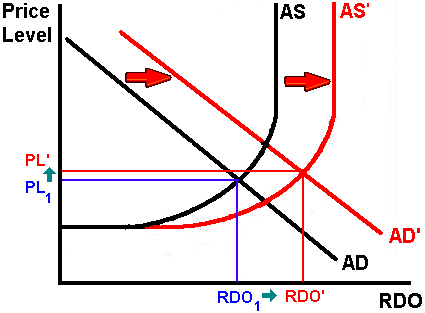
Why has AD been increasing? Let's take a look at the
determinants of AD:
AD
|
|
C
Þ AD
|
|
I
Þ AD
|
|
G
Þ AD
|
|
Xn
Þ AD
|
|
MS
Þ ¯ Interest Rates
Þ
I
Þ AD
|
|
T ¯
Þ C
Þ
AD
|
|
S ¯
Þ C
Þ
AD
|
Over the past few years consumer spending (C) has been
high as well as business investment (I). But just last
year the Federal Reserve was decreasing the money supply
(MS) causing higher interest rates to slow the increase
in AD to prevent inflation.
Why has the AS curve been increasing? Let's look at
the determinants of AS.
AS
|
|
price of resources ¯
Þ AS
|
|
productivity
Þ AS
|
|
business taxes and gov't red
tape¯ Þ
AS
|
One explanation for the increasing AS curve is that
improvements in technology over the past few years have
increased productivity.
Why is the economy slowing?
So what is happening now? The article talks
about the recent "economic
slowdown". The term "economic slowdown" is
imprecise but it indicates at least SLOWER GROWTH.
If I knew how to do animated graphics over the
internet I would represent this slower growth as
INCREASES in AD and/or AS, BUT SLOWER INCREASES. Both AS
and AD are still probably moving to the right, but now at
a slower rate. Since I can't do such animations (yet) we
will illustrate the "economic slowdown with a stationary
AS curve and an AD curve that is shifting to the left
(see figure below).
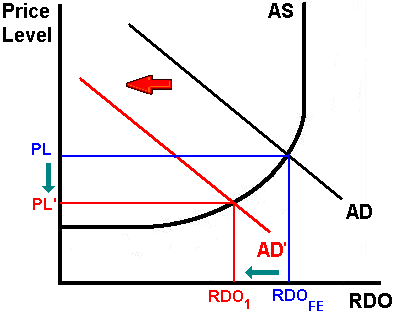
The article above clearly says " . .
.we
are still undergoing moderate growth and not a
recession."
Therefore, the graph above is incorrect, but how else can
I show an AD curve that is still shifting to the right
but SLOWING DOWN?
Why is the increase in AD slowing down (which we will
call a decrease in AD). The article mentions two
determinants:
"
Consumer
confidence plunged
to a 4-1/2-year low in February"
Expected future income ¯
Þ ¯ C today Þ
¯ AD today
"
. . . weakening expectations regarding business and
employment conditions
Profit expectations ¯
Þ I ¯
Þ¯ AD
The result is the possibility of unemployment
increasing and slowing economic growth, but these changes
should also keep inflation down.
What might the Fed do and why? (Show on a
graph.)
So what can be done? The article mentions that
the Federal Reserve in now expected to cut interest rates
which should increase AD and keep everybody working and
the economy growing.
"
. . . could
persuade the Federal Reserve to slash interest rates
.
. . "
MS Þ
¯ Interest Rates Þ
I Þ
AD
When AD increases this increases the level of real
national output and thereby keeps unemployment down.
See graph below.
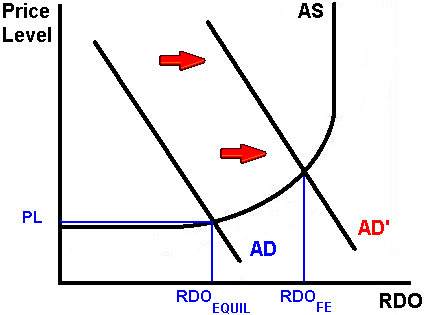
How would the tax cut help? (Show on a graph.)
I originally looked for a news article the
focused on Presidents Bush's proposed $1.6 trillion tax
cut, but couldn't find one that also discussed why the
economy is slowing down. This article only briefly
mentions the tax cut proposal:
" . . . .President
Bush's
address to Congress Tuesday night on his
tax
cut plan"
¯ Taxes
Þ C
Þ AD
When AD increases this increases the level of real
national output and thereby keeps unemployment down.
See graph below.

Are there other issues to consider?
The comments below represent my own personal political
opinion (with some economic justifications). I am a bit
reluctant to state my personal opinion, but often do so in
face-to-face courses in response to student questions. Since
this is an online course we experience less of this type of
discussion, but I think it is good for the learning process.
Therefore, please keep in mind that I am a Democrat and you
don't have to agree with me. Hopefully this will initiate a
discussion on our Discussion Forum [http://www.harpercollege.edu/bus-ss/eco/212/mhealy/wbbs/]
and give you a better understanding of the AS/AD model.
- What is an "economic slowdown"?
There is often confusion between the idea of slower
economic growth (an economic slowdown?) and negative
economic growth ( a recession). The article states:
" . . .we
are still undergoing moderate growth and not a
recession."
so the economy is still
growing, just at a slower rate. This had been the goal of
the Fed over the last couple of years. There were fears
that AD was increasing too quickly and could result in
inflation (see graph below).
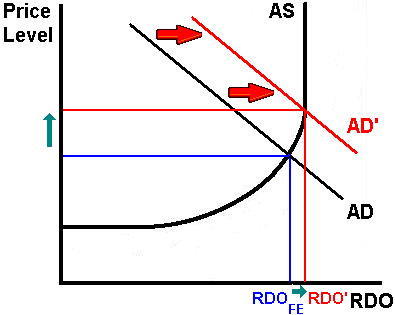
So the recent "economic
slowdown" was what the Fed wanted. Maybe the Fed raised
interest rates too much, OR maybe they prevented
inflation from occurring and nothing more needs to be
done right now.
- The "real" reason for the tax cut:
President Bush's rationale that we need a tax cut to
increase AD and prevent a recession seems to me to be a
bit ingenuous since he had been advocating a tax cut long
before the recent economic slowdown. We should ask him
that if the reason for the tax cut is now to increase AD
and prevent a recession, what was his reasoning for a tax
cut a year or two ago?
I think the real reason for the tax cut is to reduce
the size of government which has been an ongoing
Republican goal.
A decade ago the Republicans were arguing that we had
to reduce the government's debt because it would put a
burden on future generations. Now we have the opportunity
to reduce the debt, but they are arguing for a tax cut
which will reduce the debt reduction ability of the
government. I believe then, as now, they had the same
goal: to reduce the size of government.
So why don't they just say that is their goal? Well, I
believe it is because polls have shown that that is not
popular with the electorate, so they explain their
policies using whatever they can that IS popular.
If I am right, shouldn't the discussion then focus on
whether or not we should reduce the size of government
rather than disguising the true motive with the more
popular debt reduction goal of the past or the need to
fight unemployment now?
Comments? [http://www.harpercollege.edu/bus-ss/eco/212/mhealy/wbbs/]
- Whose taxes should be cut?
Another issue concerning the tax cut is WHOSE taxes
should be cut. Bush's proposal reduces tax rates for
everyone who pays taxes. The result is that the richest
Americans get a great percentage of the tax reductions
and the poor get little.
As we will see in chapter 10, if the purpose of the
tax cut is to increase consumption and thereby increase
AD to keep unemployment down, we need to ask who will
spend a greater percentage of the new (disposable) income
resulting from the tax decrease? We will see that those
with lower incomes tend to spend a larger percentage of
additional income that they may get causing Consumption
to increase more. Economists say that they have a higher
Marginal Propensity to Consume. Those with higher incomes
spend a smaller percentage of additional income causing
Consumption to increase little. That is they have a
smaller Marginal Propensity to Consume.
So if the goal of the tax decrease is to increase
Consumption it should be focused more on those with lower
incomes.
- When will the taxes be cut?
Finally, Much of the $1.6 trillion tax cut takes place
years from now. If you read the news reports carefully
you will see that it is a $1.6 trillion tax cut OVER TEN
YEARS. If the goal of the tax cut is to increase
Consumption NOW, why spread it over ten years?
Let's discuss these issues on the Discussion Forum.
http://www.harpercollege.edu/bus-ss/eco/212/mhealy/wbbs/
|
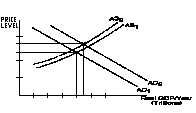
 William
Rainey Harper College
William
Rainey Harper College Adding
to the pessimism Tuesday were two reports
released by the Commerce Department.
Adding
to the pessimism Tuesday were two reports
released by the Commerce Department.


